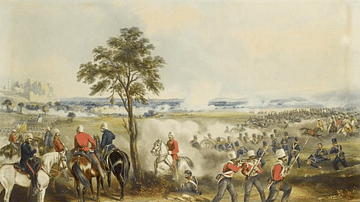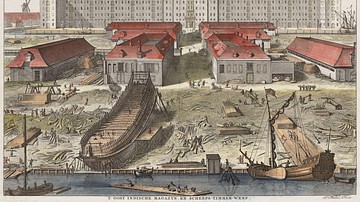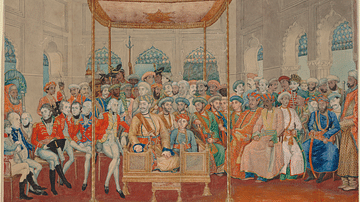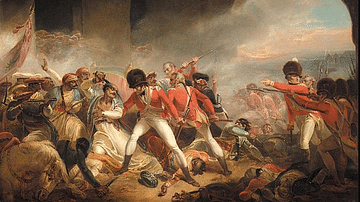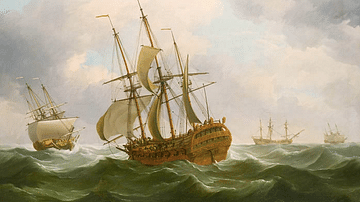The Battle of Chillianwala on 13 January 1849 was a bloody and indecisive clash between the British East India Company (EIC) and the Sikh Empire during the Second Anglo-Sikh War (1848-9). The EIC commander, General Gough, employed the dated strategy of an infantry charge against well-prepared Sikh positions, and a quarter of his men paid the ultimate price.
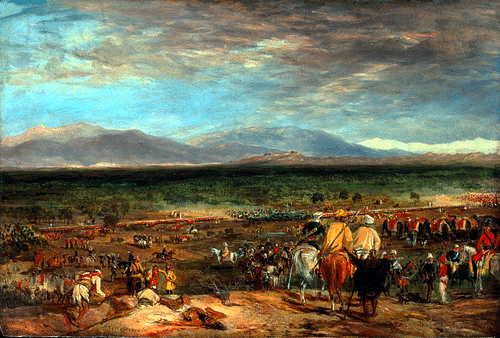
The EIC v. the Sikh Empire
The East India Company had been rapidly expanding across the Indian subcontinent since the mid-18th century. In 1845, the Company exploited the unstable political situation in the Punjab to force a war with the Sikh Empire, its last remaining sizeable enemy in India. The EIC won the First Anglo-Sikh War (1845-6) but suffered heavy losses in such engagements as the Battle of Ferozeshah and the Battle of Sobraon. The March 1846 Treaty of Lahore set harsh terms for the Sikhs as the Punjab became a 'sponsored state', and parts of the Sikh Empire – territories south of the Sutlej river – came under direct EIC rule. Many Sikh leaders and ordinary soldiers felt let down by their generals, who, with one eye on their own careers after the war, had not conducted the battles with very much aggressivity and so had allowed the EIC generals to take the initiative. Many Sikhs believed that given the closeness of the battles with the EIC, a new leadership stood a good chance of success in a second war.
The Second Anglo-Sikh War began in April 1848 after two British officers were killed in the fortress city of Multan which was then taken over by rebels. The subsequent EIC siege took two armies and ten months to complete. In the meantime, there were battles elsewhere, notably the cavalry skirmish at Ramnagar on 22 November 1848. The rebellion was now spreading across the Punjab, and a significant field engagement seemed impossible to avoid.
The Two Armies
The commander-in-chief of the EIC army and commander at Chillianwala was the aged Irishman Lieutenant-General Sir Hugh Gough (1779-1869), a crusty old veteran who believed in full-frontal bayonet charges on the enemy despite the high casualties such a strategy brought when fighting an equally well-equipped and courageous foe like the Sikhs. Gough was described by one officer as "brave as a lion but [he] has no headpiece" (James, 108). At least the old veteran led from the front, usually (like many eccentric British commanders before and since) wearing his own odd choice of battledress, in Gough's case, a long white overcoat with matching pith helmet. At Chillianwala, Gough commanded some 14,000 men, and they were certainly loyal to their commander – even when finding themselves in the field hospital, they cheered a visit from Gough. The EIC army at Chillianwala had 66 cannons.
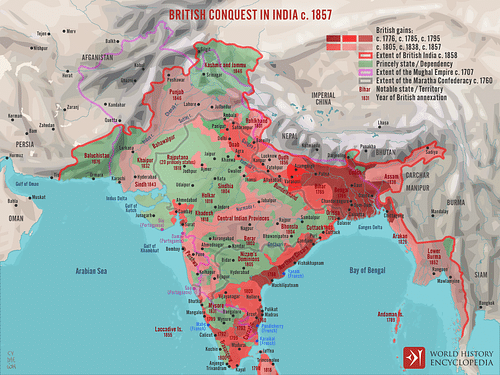
The Sikh army was commanded by Sher Singh Attariwalla, and it had dug itself defensive trenches and earthworks in an area of dense thorny bush located between the Jhelum river and the village of Chillianwala. The right flank of the Sikh army was protected by the Russool hills. This area had been host to a monumental clash of arms once before, the victory of Alexander the Great (r. 336-323 BCE) over King Porus at the 326 BCE Battle of Hydaspes.
The Sikh army numbered around 30,000 men (Gough estimated their number at 40,000) and possessed 62 cannons. The Sikh and the EIC armies were similarly armed with muskets, bayonets, swords, and cannons of all sizes and description. Both sides were equally matched in training, discipline, and courage.
Attack
Gough's plan was to smash through the very centre of the Sikh lines, and he hoped, by exploiting the join between the Sikh regular and irregular troops, this would send the reserves and less-reliable irregular forces of the enemy into a swift retreat. The general once again commenced with an artillery barrage, but one that was insufficient in duration to cause any real damage to the Sikh positions or artillery. Gough later argued that, as it was then 3 p.m., he needed to send his troops in quickly in order to avoid darkness interrupting the battle. He also maintained that: "I plainly saw that a great portion of the enemy's guns were either disabled or withdrawn. I then ordered the advance after upwards of an hour's cannonade" (Bruce, 288).

Gough ordered infantry charges in the face of a brutal Sikh artillery barrage and even fiercer musket fire. The predictable result was heavy losses. The Queen's 24th Foot Regiment, which stormed and took one battery of artillery but could not hold it, lost half its numbers, an appalling loss for the warfare of this period. The regiment suffered 231 men killed and 266 wounded. Of the regiment's 29 officers, 14 were killed and 9 badly wounded. Part of the reason for the heavy losses was the traditional and dubious strategy of having infantry charge an enemy position without firing a shot from their muskets as this was believed to slow the charge. This is confirmed by Major Smith:
The 24th were told to march up, under a storm of fire, in front of the muzzles of the guns, for several hundred yards, without attempting to stagger or dismay the enemy by making use of their arms.
(Holmes, 342)
Met with this destruction, the remainder of the 24th and two sepoy battalions hastily retreated in the face of heavy fire. Elsewhere on the battlefield, the EIC troops had more success, but the Sikhs, as usual, fought tenaciously. There were victories and losses in pockets of chaotic action across the battlefield where, because of the 8-foot high (2.4 m) bushes and the clouds of dust in the more open patches, regiments soon lost touch with each other. One dragoon described the battlefield as "broken, jungly ground" (Holmes, 370). An EIC advancing group was mauled by its own retreating horse artillery, and two cavalry brigades panicked, causing further mayhem. In the comedy of military errors, there was, too, no shortage of tragedy. A father and 17-year-old son were killed side by side, Lieutenant Colonel John Pennycuick (sometimes spelt Pennicuick) and Private Alexander Pennycuick of the 24th Regiment. The circumstances are here described by Major Smith:
Young Pennycuick had been on the sick list, was brought to the field in a dooly – there he insisted on going with the Regt into action – He retired with it, after the repulse, and, at the village, heard of his father's fate. Immediately, he went to the front in search of the body, & it would appear was killed by its side, for the two were found lying dead together. The poor boy was apparently [shot] through the back, & the ball came out almost exactly at the spot where his father was struck in front and thus – side by side – we laid them together in their graves, in the mound at Chillianwala.
(Holmes, 229)
Other infantry units charged on, unaware of the carnage going on elsewhere. A Lieutenant Sandford gives the following graphic description of his unit's charge:
Charge! rang the word through our ranks, and the men bounded forward like angry bulldogs, pouring in a murderous fire. The enemy's bullets whizzed above our heads; the very air seemed teeming with them; man after man was struck down, and rolled in the dust. But a passing glance was all we could give them. And onward we went, bearing on their line with a steadiness which nothing could resist. They fired a last volley, and then turned and fled, leaving the ground covered with dead and wounded.
(Bruce, 294)
As the sun began to set, there was still no sign of a clear victor. The battle was turning into one of those "if it can go wrong, it will" affairs for General Gough. The longer Sikh front began to outflank the British lines, and while some British troops managed to capture several Sikh artillery batteries, other EIC units became isolated, and some were even surrounded. In this chaotic battle where no commander was able to obtain a good overall view of what was happening, Gough was obliged to move back to Chillianwalla for vital water for his troops, but not before he had gathered in all of his wounded men. In the withdrawal, Gough had to leave behind four of his cannons and all the artillery pieces so far captured from the Sikhs.
Sher Singh, meanwhile, had his own problems since the continued charges of the enemy might have been reckless but they were relentless and unnerving to the Sikh troops, who might at any time choose to surrender. Accordingly, the Sikh commander requested a negotiated conclusion to the battle but was refused. Preferring to regroup what resources he had left to continue the war, Sher Singh then ordered a withdrawal of his troops to fight another day. Having already lost one-quarter of his men, Gough did not risk a pursuit.

Aftermath
Chillianwala was such a catastrophe in lives lost and casualties for the EIC – some 2,300 men – that General Gough came in for severe criticism back in Britain. As a result, the directors of the East India Company replaced Gough as commander-in-chief of the Indian army with Sir Charles Napier. However, by the time Napier arrived in the subcontinent, the next battle, still with Gough in charge, had already been decided.
The British finally stormed Multan on 22 January 1849, and the two main field armies clashed again at the Battle of Gujrat on 21 February 1849. Gough again commanded the EIC army, and Sher Singh the Sikhs. Gough had the advantage of a large reinforcement arriving from the completed campaign against Multan so that he now commanded a very impressive 23,000 men. This time, Gough used his superiority in artillery to good effect and won the battle without the high casualties seen at Chillianwala. The second war was won, and the British annexed the whole of the Punjab in March 1849, making it a province of British India.

